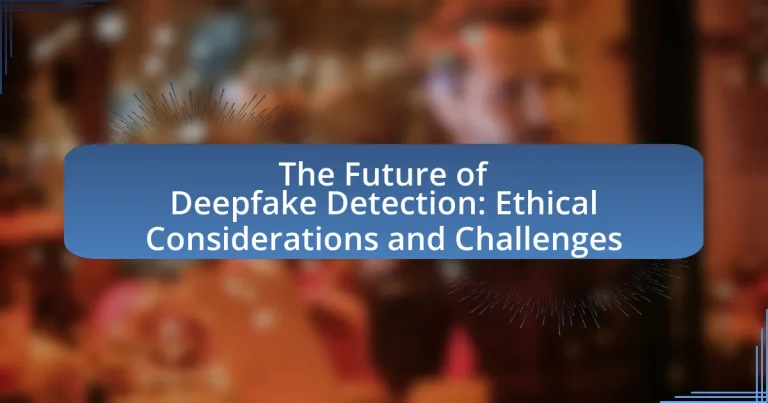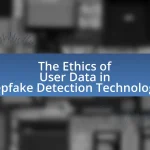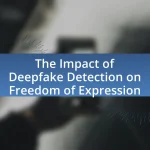Deepfakes are synthetic media generated through artificial intelligence, particularly deep learning, that can create realistic but misleading visual and audio content. This article explores the significance of deepfakes, detailing their creation process, underlying technologies, and the skills required for production. It examines potential applications in entertainment, education, and marketing, while also addressing the ethical concerns surrounding misinformation, privacy violations, and consent issues. Furthermore, the article highlights the challenges in detecting deepfakes, the limitations of current detection technologies, and the need for advanced detection methods and ethical frameworks to mitigate risks associated with this evolving technology.
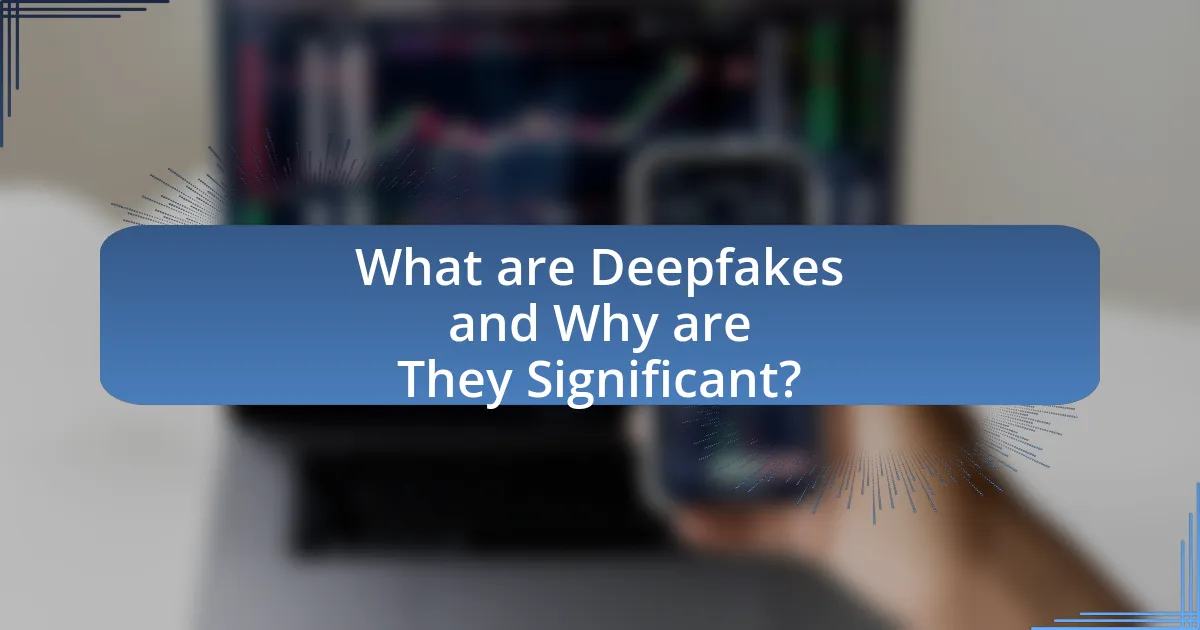
What are Deepfakes and Why are They Significant?
Deepfakes are synthetic media created using artificial intelligence techniques, particularly deep learning, to manipulate or generate visual and audio content that appears authentic. Their significance lies in their potential to mislead audiences, as they can create realistic but false representations of individuals, leading to misinformation, privacy violations, and challenges in verifying the authenticity of media. For instance, a study by the University of California, Berkeley, found that deepfake technology can produce videos that are indistinguishable from real footage, raising concerns about its implications for trust in digital content and the integrity of information.
How are Deepfakes Created?
Deepfakes are created using artificial intelligence techniques, primarily through deep learning algorithms that analyze and replicate human facial features and movements. These algorithms, particularly Generative Adversarial Networks (GANs), consist of two neural networks: a generator that creates fake images and a discriminator that evaluates their authenticity. The generator improves its output based on feedback from the discriminator until the generated images are indistinguishable from real ones. This process requires large datasets of images and videos of the target individual to train the model effectively, ensuring high fidelity in the final output.
What technologies underpin the creation of Deepfakes?
Deepfakes are primarily created using artificial intelligence technologies, particularly deep learning algorithms. These algorithms, such as Generative Adversarial Networks (GANs), enable the synthesis of realistic images and videos by training on large datasets of existing media. GANs consist of two neural networks, a generator and a discriminator, that work in opposition to improve the quality of the generated content. Additionally, techniques like autoencoders and facial recognition software are often employed to enhance the accuracy and realism of the deepfake outputs. The effectiveness of these technologies is evidenced by the increasing sophistication of deepfake content, which has raised significant ethical concerns regarding misinformation and privacy.
What skills are necessary for producing Deepfakes?
Producing Deepfakes requires skills in machine learning, computer vision, and video editing. Machine learning expertise is essential for understanding and implementing algorithms that generate realistic synthetic media. Proficiency in computer vision allows creators to manipulate and analyze visual data effectively, ensuring the accuracy of facial movements and expressions. Additionally, video editing skills are crucial for seamlessly integrating Deepfake content into existing footage, enhancing realism. These skills collectively enable the creation of convincing Deepfakes, which have been demonstrated in various studies highlighting their potential for both entertainment and misinformation.
What are the Potential Uses of Deepfakes?
Deepfakes have potential uses in various fields, including entertainment, education, and marketing. In entertainment, they can create realistic visual effects and enable actors to portray characters in innovative ways, as seen in films where deceased actors are digitally resurrected. In education, deepfakes can enhance learning experiences by simulating historical figures or events, making lessons more engaging. In marketing, brands can utilize deepfake technology to create personalized advertisements that resonate with consumers, improving engagement rates. These applications demonstrate the versatility of deepfakes while also raising ethical considerations regarding authenticity and consent.
How can Deepfakes be used in entertainment and media?
Deepfakes can be used in entertainment and media to create realistic visual effects, enhance storytelling, and enable innovative content creation. For instance, filmmakers can use deepfake technology to digitally resurrect deceased actors for new roles, as seen in the posthumous appearance of Carrie Fisher in “Star Wars: The Rise of Skywalker.” Additionally, deepfakes allow for the seamless replacement of actors’ faces in scenes, enabling more flexible casting and reducing production costs. The technology also facilitates personalized content, such as customized advertisements featuring familiar faces, which can increase viewer engagement. These applications demonstrate the potential of deepfakes to transform traditional media practices while raising ethical considerations regarding authenticity and consent.
What are the implications of Deepfakes in politics and misinformation?
Deepfakes have significant implications in politics and misinformation, primarily by enabling the creation of highly convincing but false representations of individuals, which can distort public perception and influence political outcomes. For instance, deepfake technology can be used to fabricate speeches or actions of political figures, leading to the spread of false narratives that can sway voter opinions or incite social unrest. A study by the University of California, Berkeley, found that 96% of deepfake videos are pornographic, but the remaining 4% can be politically motivated, highlighting the potential for misuse in electoral contexts. Furthermore, the rapid dissemination of deepfakes through social media platforms exacerbates the challenge of verifying information, as seen during the 2020 U.S. elections when manipulated videos circulated widely, raising concerns about their impact on democratic processes.
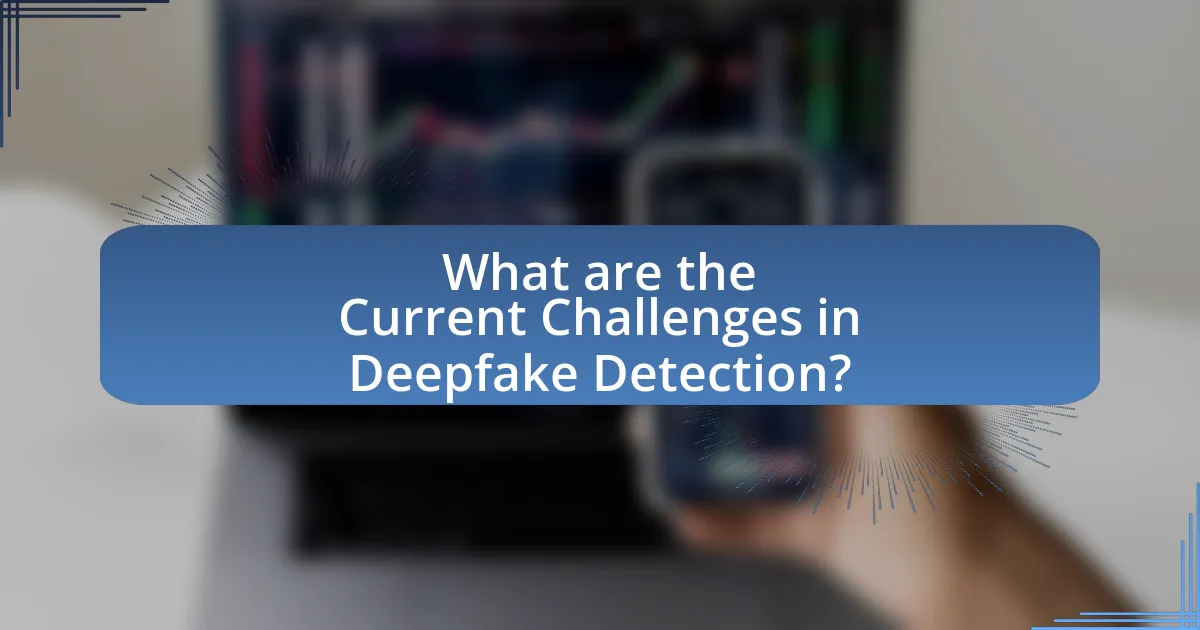
What are the Current Challenges in Deepfake Detection?
Current challenges in deepfake detection include the rapid advancement of deepfake technology, which outpaces detection methods, and the increasing sophistication of algorithms that create highly realistic content. These challenges are compounded by the lack of standardized benchmarks for evaluating detection tools, making it difficult to assess their effectiveness. Additionally, the prevalence of deepfake content on social media platforms complicates timely detection and response efforts, as misinformation can spread quickly before detection systems can intervene. Research indicates that as deepfake generation techniques improve, traditional detection methods struggle to keep up, highlighting the need for continuous innovation in detection technologies.
Why is Detecting Deepfakes Difficult?
Detecting deepfakes is difficult due to the advanced techniques used in their creation, which often employ artificial intelligence and machine learning algorithms that can produce highly realistic images and videos. These technologies, such as Generative Adversarial Networks (GANs), enable the synthesis of facial expressions and movements that closely mimic real human behavior, making it challenging for traditional detection methods to identify inconsistencies. Additionally, the rapid evolution of deepfake technology means that detection tools must constantly adapt, as new deepfake generation techniques emerge, further complicating the identification process.
What are the limitations of current detection technologies?
Current detection technologies face several limitations, including high false positive rates, difficulty in detecting novel deepfake techniques, and reliance on large datasets for training. High false positive rates can lead to misidentification of legitimate content as fake, undermining trust in detection systems. Additionally, as deepfake technology evolves, detection methods struggle to keep pace, often failing to identify new manipulation techniques. Furthermore, many detection algorithms require extensive and diverse datasets to train effectively, which can be challenging to obtain, especially for emerging deepfake methods. These limitations hinder the effectiveness and reliability of current detection technologies in combating deepfakes.
How do evolving Deepfake techniques challenge detection efforts?
Evolving Deepfake techniques significantly challenge detection efforts by continuously improving the realism and sophistication of manipulated media. As these techniques leverage advanced machine learning algorithms, such as Generative Adversarial Networks (GANs), they produce increasingly convincing fake videos and audio that can evade traditional detection methods. Research indicates that the rapid advancement in deep learning capabilities allows for the creation of deepfakes that are harder to distinguish from authentic content, making it difficult for existing detection tools to keep pace. For instance, a study published in 2020 by Korshunov and Marcel demonstrated that state-of-the-art detection systems struggled to identify deepfakes generated by the latest GAN models, highlighting the ongoing arms race between deepfake creation and detection technologies.
What Ethical Concerns Arise from Deepfake Technology?
Deepfake technology raises significant ethical concerns, primarily related to misinformation, consent, and privacy violations. Misinformation arises when deepfakes are used to create false narratives, potentially influencing public opinion or inciting violence, as seen in instances where manipulated videos of politicians have circulated online. Consent issues emerge when individuals’ likenesses are used without permission, leading to potential reputational harm and exploitation, particularly in non-consensual pornography cases. Privacy violations occur when deepfake technology is employed to create unauthorized representations of individuals, infringing on their personal rights and autonomy. These concerns highlight the need for regulatory frameworks to address the implications of deepfake technology on society.
How do Deepfakes impact privacy and consent?
Deepfakes significantly undermine privacy and consent by enabling the unauthorized manipulation of individuals’ likenesses and voices. This technology allows malicious actors to create realistic but fabricated content, often without the consent of the individuals depicted, leading to potential reputational harm and emotional distress. For instance, a study by the University of California, Berkeley, found that 96% of deepfake videos are pornographic in nature, often targeting women, which highlights the violation of personal privacy and consent. Furthermore, the ease of creating and disseminating deepfakes complicates legal frameworks surrounding consent, as existing laws may not adequately address the rapid evolution of this technology.
What are the potential consequences of Deepfake misuse?
The potential consequences of Deepfake misuse include significant harm to individuals’ reputations, manipulation of public opinion, and threats to national security. Misuse of Deepfake technology can lead to the creation of misleading videos that damage personal and professional reputations, as seen in cases where fabricated content has resulted in public backlash against individuals. Additionally, Deepfakes can be weaponized to spread misinformation during elections, influencing voter behavior and undermining democratic processes. National security is also at risk, as Deepfakes can be used to impersonate officials or create false narratives that could incite conflict or panic. These consequences highlight the urgent need for effective detection methods and ethical guidelines surrounding the use of Deepfake technology.
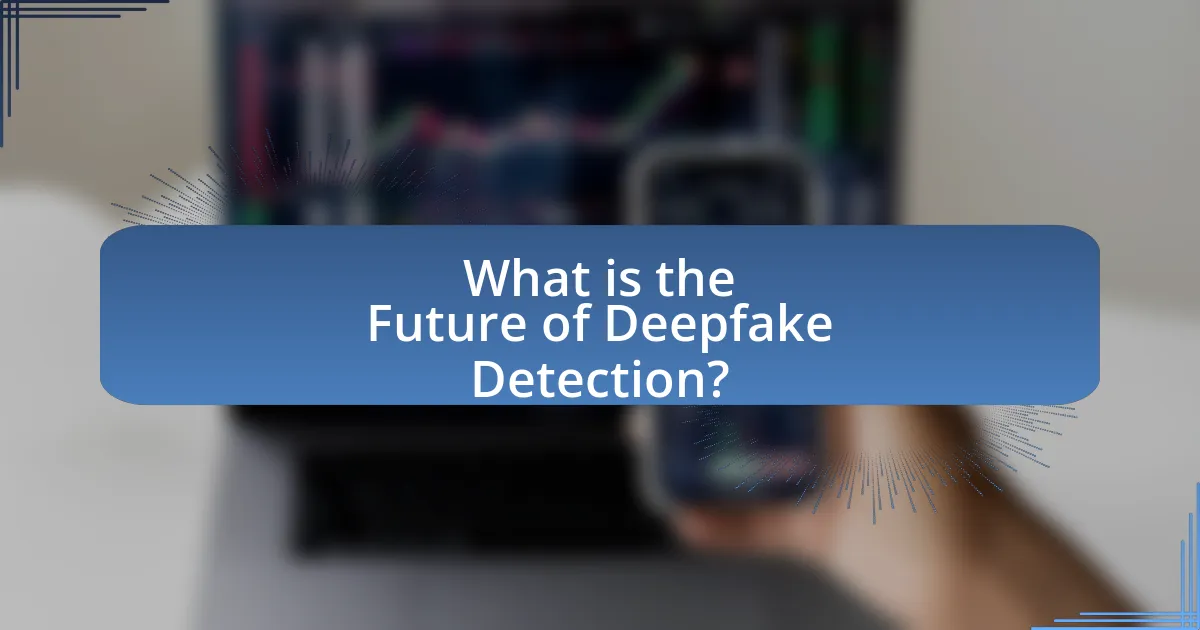
What is the Future of Deepfake Detection?
The future of deepfake detection is expected to involve advanced machine learning algorithms and real-time analysis to combat the increasing sophistication of deepfake technology. As deepfake creation tools become more accessible and powerful, detection methods will need to evolve, utilizing techniques such as neural networks and blockchain verification to ensure authenticity. Research indicates that the development of robust detection systems is critical, as evidenced by studies showing that deepfake detection accuracy can improve significantly with the integration of multi-modal data sources, such as audio and visual cues.
How can Technology Evolve to Improve Detection?
Technology can evolve to improve detection by integrating advanced machine learning algorithms and real-time analysis capabilities. These advancements enable systems to identify deepfake content more accurately by analyzing patterns and inconsistencies in audio and visual data. For instance, the use of convolutional neural networks (CNNs) has shown a significant increase in detection rates, with studies indicating that CNNs can achieve over 90% accuracy in distinguishing between real and manipulated media. Additionally, incorporating blockchain technology can enhance the traceability of digital content, providing a verifiable history that aids in identifying alterations.
What advancements are being made in AI and machine learning for detection?
Advancements in AI and machine learning for detection include the development of sophisticated algorithms that enhance the identification of deepfakes. Recent research has focused on using convolutional neural networks (CNNs) and recurrent neural networks (RNNs) to analyze video and audio data for inconsistencies that indicate manipulation. For instance, a study published in 2023 by the University of California demonstrated that a new model could achieve over 95% accuracy in detecting deepfake videos by examining facial movements and audio synchronization. These advancements are crucial as they provide tools to combat misinformation and protect digital integrity in an era where deepfakes are increasingly prevalent.
How can collaboration between tech companies enhance detection efforts?
Collaboration between tech companies can enhance detection efforts by pooling resources, expertise, and data to develop more sophisticated algorithms and detection tools. When companies share their findings and technologies, they can create a more comprehensive understanding of deepfake techniques, leading to improved detection accuracy. For instance, a study by the MIT Media Lab found that collaborative approaches in AI development can significantly reduce error rates in identifying manipulated media. By working together, tech companies can also establish industry standards and best practices, which can further streamline detection processes and improve overall effectiveness in combating deepfakes.
What Ethical Frameworks are Needed for Deepfake Detection?
Ethical frameworks needed for deepfake detection include transparency, accountability, and fairness. Transparency ensures that the algorithms used for detection are understandable and accessible, allowing stakeholders to comprehend how decisions are made. Accountability mandates that creators and distributors of deepfakes are held responsible for their content, which can deter malicious use. Fairness involves ensuring that detection technologies do not disproportionately impact specific groups, thus promoting equitable treatment across diverse populations. These frameworks are essential to mitigate the risks associated with deepfakes, as evidenced by the increasing prevalence of misinformation and its potential to harm individuals and society.
How can regulations balance innovation and ethical considerations?
Regulations can balance innovation and ethical considerations by establishing clear guidelines that promote responsible development while encouraging technological advancement. For instance, regulations can mandate transparency in deepfake technology, requiring developers to disclose the use of such tools in media, which fosters accountability and public trust. Additionally, frameworks like the EU’s General Data Protection Regulation (GDPR) illustrate how legal structures can protect individual rights without stifling innovation, as they set standards for data usage that companies must follow while still allowing for creative applications of technology. This approach ensures that ethical concerns are addressed without hindering the potential for new and beneficial innovations.
What role do public awareness and education play in ethical Deepfake use?
Public awareness and education are crucial in promoting ethical Deepfake use by informing individuals about the technology’s capabilities and potential risks. Increased understanding helps users discern between legitimate and manipulated content, reducing the likelihood of misinformation and malicious use. For instance, educational initiatives can highlight the ethical implications of Deepfakes, such as consent and authenticity, fostering a culture of responsible creation and consumption. Research indicates that informed users are more likely to engage critically with media, as demonstrated in studies showing that media literacy programs significantly improve individuals’ ability to identify manipulated content.
What Best Practices Should be Adopted for Deepfake Detection?
Best practices for deepfake detection include utilizing advanced machine learning algorithms, implementing multi-modal analysis, and fostering collaboration among researchers and industry stakeholders. Advanced machine learning algorithms, such as convolutional neural networks, have shown effectiveness in identifying subtle inconsistencies in deepfake videos. Multi-modal analysis, which combines visual, audio, and textual data, enhances detection accuracy by cross-referencing multiple sources of information. Collaboration among researchers, tech companies, and policymakers is crucial for sharing knowledge, developing standardized detection methods, and addressing ethical concerns. These practices are supported by studies indicating that a multi-faceted approach significantly improves detection rates and reduces the potential for misinformation.
